Related Research Articles

Hindko is a cover term for a diverse group of Lahnda dialects spoken by several million people of various ethnic backgrounds in several areas in northwestern Pakistan, primarily in the provinces of Khyber Pakhtunkhwa and northwestern regions of Punjab.
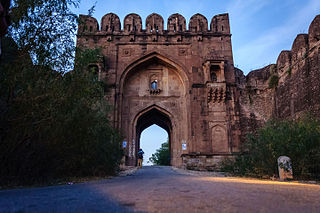
Jhelum District, is partially in Pothohar Plateau, and partially in Punjab Plain of the Punjab province of Pakistan. Jhelum is one of the oldest districts of Punjab. It was established on 23 March 1849. According to the 1998 census, the district had a population of 936,957, of which 31.48% were urban. Jhelum District has a diverse population of 1,103,000 (2006). Jhelum is known for providing many soldiers to the British and later to the Pakistan armed forces due to which it is also known as 'city of soldiers' or 'land of martyrs and warriors'. The district of Jhelum stretches from the river Jhelum almost to the Indus. Salt is quarried at the Mayo mine in the Salt Range. There are two coal mines in the district from which the North-Western railway obtains parts of its supply. These are the only coal mines in Punjab province which are in working condition. The chief center of the salt trade is Pind Dadan Khan. The district is crossed by the main line of the North-Western railway and also traversed along the south by a branch line. It is located in the north of the Punjab province, Jhelum district is bordered by Sargodha and Mandi Bahauddin to its south, Khushab to its southwest, Jhelum River to its south and east, Gujrat to its east, Chakwal to its west, Mirpur to its northeast, and Rawalpindi to its north.

Northern Pakistan is a tourism region in the northern and north-western parts of Pakistan, comprising the administrative units of Gilgit-Baltistan, Azad Kashmir, Khyber Pakhtunkhwa, and the Pothohar Plateau in Punjab. The first two territories are a part of the wider Kashmir region. Usually, the federal territory of Islamabad is also considered to be in northern Pakistan. It is a mountainous region straddling the Himalayas, Karakoram and the Hindu Kush mountain ranges, containing many of the highest peaks in the world and some of the longest glaciers outside polar regions. Northern Pakistan accounts for a high level of Pakistan's tourism industry.

Rohtas Fort is a 16th-century fortress located near the city of Dina in Jhelum district of the Punjab province of Pakistan. Raja Todar Mal, the minister of the Afghan king Sher Shah Suri, supervised the construction of the fort, which is now one of the largest and most formidable in Punjab.

Deosai National Park is a high-altitude alpine plain (plateau) and National Park located between and Skardu District, and in Gilgit-Baltistan, Pakistan.
Astore Wildlife Sanctuary is as wildlife refuge located in Gilgit–Baltistan, Pakistan. It is within the Astore District, between Nanga Parbat 8,126 metres (26,660 ft) to the west and the plains of Deosai to the east, and about 11 km (6.8 mi) from the town of Bungi. Its area is approximately 414.72 km2 (160.12 sq mi) and its altitude is from 1,212 m (3,976 ft) to 6,060 m (19,880 ft).
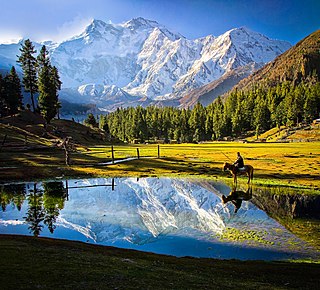
Fairy Meadows, named by German climbers and locally known as Joot, is a grassland near one of the base camp sites of the Nanga Parbat, located in Diamer District, Gilgit-Baltistan, Pakistan. At an altitude of about 3,300 metres (10,800 ft) above sea level, it serves as the launching point for trekkers summiting on the Rakhiot face of the Nanga Parbat. In 1995, the Government of Pakistan declared Fairy Meadows a National Park.
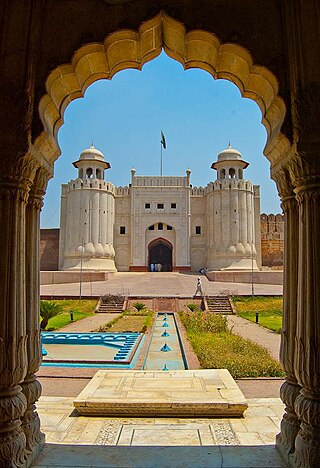
Tourism in Pakistan is a growing industry. In 2010, Lonely Planet termed Pakistan "tourism's 'next big thing'". The country is geographically and ethnically diverse, and has a number of historical and cultural heritage sites. Condé Nast Traveller ranked Pakistan The Best Holiday Destination for 2020 and also declared it the third-highest potential adventure destination in the world for 2020. As security in the country improves, tourism increases; in two years, it has increased by more than 300%. The Pakistani government had launched online visa services for 175 countries and 50 countries were offered visa on arrival, making visiting Pakistan easier. The country received an influx of travel vloggers, who promoted the characteristics of the country, such as in the Northern Pakistan, like Hunza and Skardu.

Neelum is a district of Pakistan-administered Azad Kashmir in the disputed Kashmir region. It is the northernmost of 10 districts located within the Pakistani-administered territory of Azad Kashmir. Taking up the larger part of the Neelum Valley, the district has a population of around 191,000 people. It was among the worst-hit areas of Pakistan during the 2005 Kashmir earthquake.

The wildlife of Pakistan comprises a diverse flora and fauna in a wide range of habitats from sea level to high elevation areas in the mountains, including 195 mammal, 668 bird species and more than 5000 species of Invertebrates. This diverse composition of the country's fauna is associated with its location in the transitional zone between two major zoogeographical regions, the Palearctic, and the Oriental. The northern regions of Pakistan, which include Khyber Pakhtunkhwa and Gilgit Baltistan include portions of two biodiversity hotspot, Mountains of Central Asia and Himalayas.

Pakistan's native fauna reflect its varied climatic zones. The northern Pakistan, which includes Khyber Pakhtunkhwa and Gilgit Baltistan, has portions of two biodiversity hotspots, Mountains of Central Asia and Himalayas.
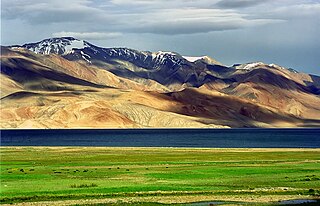
The Karakoram-West Tibetan Plateau alpine steppe is a montane grasslands and shrublands ecoregion found in parts of Pakistan, China, Afghanistan, and India.
Central Jail Rawalpindi is a prominent prison in Rawalpindi, Pakistan.
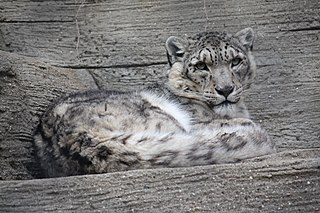
Conservation in Pakistan is the act of preserving, guarding, or protecting, biodiversity, environment, and natural resources of Pakistan.
Major (Retd.) Muhammad Nawaz Khan, was a Pakistani writer, historian, columnist, and poet of the English, Pashto and Urdu languages. His work had mostly been focused on history of the Pashtuns, the Gandhara civilization and the British legacy in Pakistan.
The Ghamot National Park Ghamot National Park is a national park in Azad Kashmir, Pakistan. It is located in Neelam District of AJK and it was established in 2004. Conservation efforts in the Gumot National Park are funded by the Global Environment Facility Small Grants Programme and implemented by the Himalayan Wildlife Foundation. The national park is significant as it hosts a connected population of the threatened Himalayan Brown Bear of Pakistan, connected through a network of national parks in northern Pakistan including the Deosai National Park and Musk Deer National Park. The park also hosts a population of the threatened musk deer.
Formerly or currently considered subspecies or populations of brown bears have been listed as follows:
The Gurez National Park, also known as Musk Deer National Park, is one of the protected areas of Pakistan. It is located in Neelum District in Azad kashmir, Pakistan, besides the Neelum River in the Gurez valley. It is located in the high Himalayas and Pir Panjal Range. It is a thirty-five minute drive from Gurez tehsil. It is also known as Gurez valley national park.

Islamabad Wildlife Management Board (IWMB) is a Pakistani government body operating under the Ministry of Climate Change. It is mandated to protect, manage, and conserve the Margalla Hills National Park as its legal custodian.
References
- 1 2 Nawaz, Ali (2008). "Ecology, genetics and conservation of Himalayan brown bear" (PDF). PhD Thesis. 1.
- ↑ Nawaz, Muhammad Ali; Swenson, Jon E.; Zakaria, Vaqar (2008-09-01). "Pragmatic management increases a flagship species, the Himalayan brown bears, in Pakistan's Deosai National Park". Biological Conservation. 141 (9): 2230–2241. doi:10.1016/j.biocon.2008.06.012. ISSN 0006-3207.
- 1 2 3 "Salman Rashid: Deosai National Park Gets Going on Uncertain Feet" . Retrieved 2019-06-07.
- ↑ Bellemain, Eva; Nawaz, Muhammad Ali; Valentini, Alice; Swenson, Jon E.; Taberlet, Pierre (2007-02-01). "Genetic tracking of the brown bear in northern Pakistan and implications for conservation". Biological Conservation. 134 (4): 537–547. doi:10.1016/j.biocon.2006.09.004. ISSN 0006-3207.
- ↑ Koh, Lian Pin; Manish, Kumar; Pandit, Maharaj K. (2014-11-01). "Dancing on the Roof of the World: Ecological Transformation of the Himalayan Landscape". BioScience. 64 (11): 980–992. doi: 10.1093/biosci/biu152 . ISSN 0006-3568.
- 1 2 3 "Project Detail". sgp.undp.org. Retrieved 2019-06-07.
- 1 2 Ovais, Fareeha Irfan (2015-02-22). "Conservation: Brown bears in the land of the giant". DAWN.COM. Retrieved 2019-06-07.
- ↑ "Project Detail". sgp.undp.org. Retrieved 2019-06-07.
- ↑ Nawaz, Ali (2007). "Status of the brown bear in Pakistan" (PDF). Ursus. 18: 89. doi:10.2192/1537-6176(2007)18[89:SOTBBI]2.0.CO;2. S2CID 59448774. Archived from the original (PDF) on 2019-06-07 – via JSTOR.
- ↑ Walkabout Films (2015-02-25), DEOSAI - The Last Sanctuary (English Documentary) , retrieved 2019-06-09
- ↑ Masood, Asad. "Enhancing Public Facilities at Rohtas Fort – USAID" . Retrieved 2019-06-09.
- ↑ "Rohtas Fort". UNESCO World Heritage Centre. Retrieved 2019-06-09.